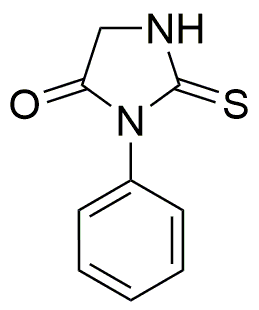Phenylthiohydantoin-glycine is widely utilized in research focused on
- Protein Sequencing: This compound is used in Edman degradation, a method for sequencing amino acids in proteins, allowing researchers to determine the structure and function of proteins in various biological systems.
- Peptide Synthesis: It serves as a building block in the synthesis of peptides, which are crucial in drug development and therapeutic applications, particularly in designing targeted treatments for diseases.
- Biochemical Assays: The compound is employed in biochemical assays to study enzyme activity and interactions, providing insights into metabolic pathways and potential drug targets.
- Analytical Chemistry: It is used in chromatography techniques for the separation and analysis of complex mixtures, enhancing the accuracy of chemical analysis in pharmaceuticals and environmental testing.
- Research in Neurobiology: Researchers utilize this compound to investigate neuropeptides and their roles in neurological functions, contributing to the understanding of brain chemistry and potential treatments for neurological disorders.
Informations générales
Propriétés
Sécurité et réglementation
Applications
Phenylthiohydantoin-glycine is widely utilized in research focused on
- Protein Sequencing: This compound is used in Edman degradation, a method for sequencing amino acids in proteins, allowing researchers to determine the structure and function of proteins in various biological systems.
- Peptide Synthesis: It serves as a building block in the synthesis of peptides, which are crucial in drug development and therapeutic applications, particularly in designing targeted treatments for diseases.
- Biochemical Assays: The compound is employed in biochemical assays to study enzyme activity and interactions, providing insights into metabolic pathways and potential drug targets.
- Analytical Chemistry: It is used in chromatography techniques for the separation and analysis of complex mixtures, enhancing the accuracy of chemical analysis in pharmaceuticals and environmental testing.
- Research in Neurobiology: Researchers utilize this compound to investigate neuropeptides and their roles in neurological functions, contributing to the understanding of brain chemistry and potential treatments for neurological disorders.
Documents
Fiches de données de sécurité (FDS)
La FDS fournit des informations de sécurité complètes sur la manipulation, le stockage et l’élimination du produit.
Spécifications du produit (PS)
Le PS fournit une description complète des propriétés du produit, notamment sa composition chimique, son état physique, sa pureté et les exigences de stockage. Il détaille également les plages de qualité acceptables et les applications prévues du produit.
Certificats d'analyse (COA)
Recherchez des certificats d'analyse (COA) en saisissant le numéro de lot du produit. Les numéros de lot et de lot se trouvent sur l'étiquette d'un produit, après les mots « Lot » ou « Lot de fabrication ».
Numéro de catalogue
Numéro de lot/série
Certificats d'origine (COO)
Ce certificat d'exploitation confirme le pays dans lequel le produit a été fabriqué, et détaille également les matériaux et composants utilisés et s'il est issu de sources naturelles, synthétiques ou autres sources spécifiques. Ce certificat peut être requis pour les douanes, le commerce et la conformité réglementaire.
Numéro de catalogue
Numéro de lot/série
Fiches de données de sécurité (FDS)
La FDS fournit des informations de sécurité complètes sur la manipulation, le stockage et l’élimination du produit.
DownloadSpécifications du produit (PS)
Le PS fournit une description complète des propriétés du produit, notamment sa composition chimique, son état physique, sa pureté et les exigences de stockage. Il détaille également les plages de qualité acceptables et les applications prévues du produit.
DownloadCertificats d'analyse (COA)
Recherchez des certificats d'analyse (COA) en saisissant le numéro de lot du produit. Les numéros de lot et de lot se trouvent sur l'étiquette d'un produit, après les mots « Lot » ou « Lot de fabrication ».
Numéro de catalogue
Numéro de lot/série
Certificats d'origine (COO)
Ce certificat d'exploitation confirme le pays dans lequel le produit a été fabriqué, et détaille également les matériaux et composants utilisés et s'il est issu de sources naturelles, synthétiques ou autres sources spécifiques. Ce certificat peut être requis pour les douanes, le commerce et la conformité réglementaire.


